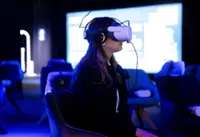The use of VR in the education sector is still rare, mainly due to high costs. — Image by jcomp on Freepik
BERLIN: Instead of going on language trips to other countries, why not order an espresso in an Italian cafe while sitting at home on the couch?
What sounds a bit like science fiction is possible with the help of virtual reality (VR). “In virtual environments, learners can actively act and communicate, regardless of location,” says educator Timo Ahlers, who researches VR at the University of Potsdam in Germany.





